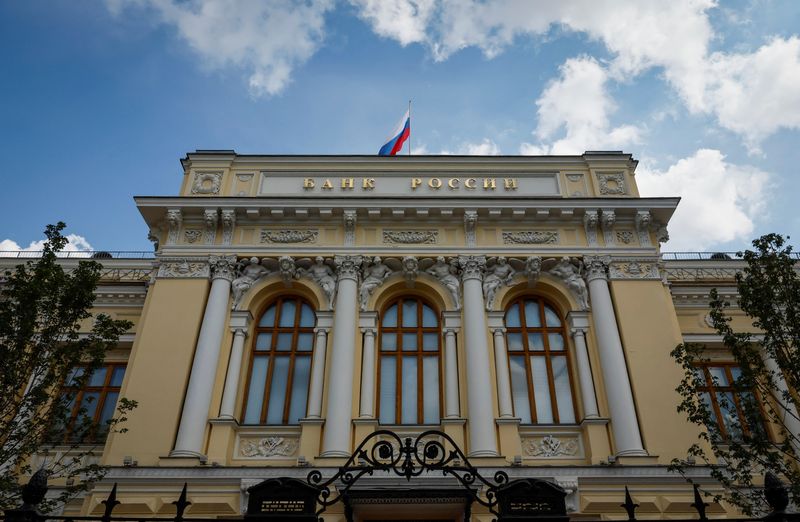By Elena Fabrichnaya and Gleb Bryanski
MOSCOW (Reuters) -Russia’s central bank hiked its key interest rate by 200 basis points on Friday to 21%, the highest level since the early years of President Vladimir Putin’s rule, when Russia was recovering from the chaos that followed the collapse of the Soviet Union.
The move, driven by massive increases in state spending, especially on the military, also brings the rate above the level seen during the market panic at the start of what Russia calls its “special military operation” in Ukraine in February 2022.
The central bank said the hike was needed to fight inflation, currently at 8.4%, adding that inflationary expectations among the public have reached their highest level since the start of the year.
“Further tightening of monetary policy is required to ensure that inflation returns to target and to reduce inflation expectations,” the regulator said.
Russia, which has just hosted a summit of the BRICS group of countries, has by far the highest key interest rate among the core BRICS members, who also include China, India, Brazil and South Africa.
The regulator said another hike was possible at its next policy meeting and also updated its inflation forecast for 2025 to 4.5-5.0%, signalling that its 4% policy target was out of reach next year.
“The central bank admitted that it will not be able to bring inflation back to target next year,” said economist Evgeny Kogan, calling the move “a capitulation in the face of inflation”.
INFLATIONARY BUDGET
Economists also noted that the regulator’s forecast for the average key rate in 2024 created room for a further hike to 23% before the end of the year. The central bank’s governor Elvira Nabiullina told a news conference there were “no limits” for the key rate level.
Most analysts polled by Reuters had expected a 100 bps hike. The central bank said it took into account the new draft budget, seen as inflationary due to a higher-than-expected deficit of 1.7% of GDP for this year and massive hikes in utility tariffs.
The new benchmark rate is the highest since it was introduced in 2013, replacing the refinancing rate as the main market guidance.
Soon after Putin took power in 2000, he launched economic reforms to stabilize Russia’s economy after the 1998 financial meltdown that enabled the central bank to bring the refinancing rate to below 20% in Feb. 2003 and keep it below that level until now.
The current weakness of the Russian currency, with the official exchange rate against the U.S. dollar down by over 12% since early August, is also viewed by analysts as a strong inflationary factor.
RATE HIKE
Friday’s hike also highlights political support for the central bank’s leadership, which faced unprecedented pressure from some of Russia’s most powerful businessmen, including the heads of the country’s largest oil and defence companies, to halt the tightening cycle.
Official data shows, however, that despite the rate hikes, corporate lending has not slowed.
The International Monetary Fund (IMF), which cancelled its mission to Russia last month after protests by several European countries, reduced its forecast for Russian economic growth by 0.2 percentage points to 1.3% in 2025 from 3.6% this year.
The Fund cited slowing consumption and investment growth amid a less tight labour market and more moderate wage growth. It said its projections assumed the central bank maintained a tight monetary policy stance.
Both the IMF and the central bank described the current state of Russia’s economy as “overheated”. Russia officially sees economic growth slowing to 2.5% from an expected 3.9% this year.
The central bank raised its interest rate to 20% in February 2022 to calm markets unsettled by Russia’s actions in Ukraine and to stop capital outflow. It lowered the rate to 17% in April 2022.

